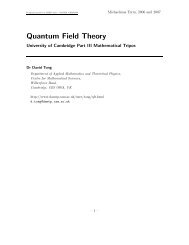CHAPTER 4. THERMODYNAMICS: THE FIRST LAW
CHAPTER 4. THERMODYNAMICS: THE FIRST LAW
CHAPTER 4. THERMODYNAMICS: THE FIRST LAW
Create successful ePaper yourself
Turn your PDF publications into a flip-book with our unique Google optimized e-Paper software.
4-10<br />
held constant, all of the heat goes into producing a corresponding change in temperature (i.e., it all<br />
goes into changing the internal energy), whereas when the pressure is held constant, some of the heat<br />
goes into work of expansion or contraction. Therefore, it is to be expected that<br />
since a given q results in a smaller T.<br />
P<br />
C P > CV<br />
When a monatomic ideal gas is heated at constant volume, all of the heat goes into increasing<br />
the translational kinetic energy of the atoms. However, in the case of molecules, there are other<br />
energy modes available in addition to kinetic energy. Specifically, molecules may have rotational<br />
and vibrational energy. Therefore, when a molecular gas is heated, the resulting energy increase is<br />
distributed among all three energy modes. Statistically, it may be shown that the amount of energy<br />
per mole that goes into each energy mode is<br />
U m = N m(½RT),<br />
where N is related to the number of degrees of freedom and the number of different types of energy<br />
m<br />
(e.g., kinetic and potential) associated with the energy mode, and R is the gas constant. This result,<br />
which assumes that all energy modes have continuous energy distributions, is known as the<br />
equipartition theorem. The number of degrees of freedom for a molecule, D , is related to the<br />
m<br />
number of coordinates required to specify the position of each atom. The degrees of freedom<br />
associated with the various energy modes of a molecule and the corresponding values of N are m<br />
summarized below;<br />
N = D , N = D , N = 2D<br />
tran tran rot rot vib vib<br />
D = 3n tot<br />
D = 3 tran<br />
D = 2 (linear molecule) or 3 (nonlinear)<br />
rot<br />
D = 3n !5 (linear molecule) or 3n ! 6 (nonlinear)<br />
vib<br />
The equipartition theorem may be used to estimate the heat capacities of gas-phase molecules at high<br />
temperatures.<br />
Example: Estimate the value of C for CO .<br />
V 2

















